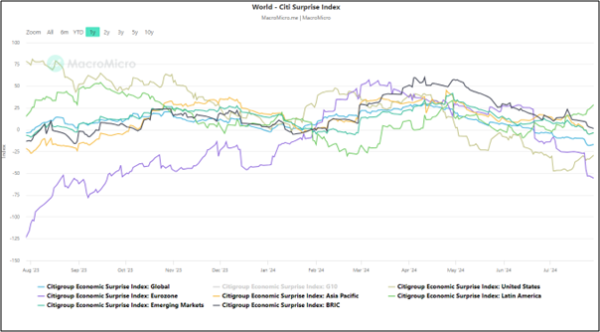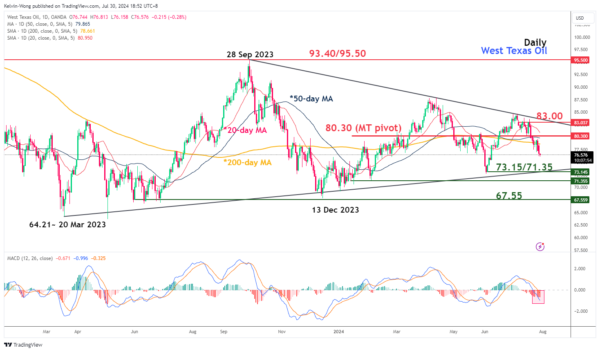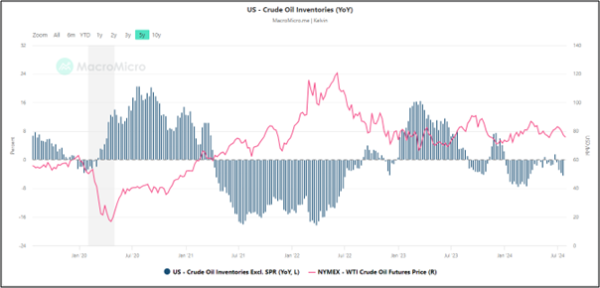- Citigroup Economic Surprise Indices across the different regions (except for Latin America) on average are suggesting lackluster economic growth.
- US crude oil inventories (excluding SPR) are showing signs of a build-up.
- Technical factors are suggesting further potential weakness for WTI crude oil below US$80.30 key medium-term resistance.
Since its high of US$84.74 printed on 5 July 2024, the price actions of West Texas Oil CFD (a proxy of the WTI crude oil futures) have tumbled by 10% to print a current intraday low of US$76.16 at this time of the writing in light of sluggish demand from China and the lack of direct fiscal stimulus measures from China top policymakers after the conclusion of The Third Plenum; a twice-a-decade work plan meeting to set China’s economy strategy for the medium-term.
In addition, Donald Trump, the Republican US presidential nominee spoke about lowering the inflationary pressures in the US by reducing energy costs through an increase in domestic oil and gas production during the Republican National Convention on 18 July. In turn, added further downside pressure on WTI crude oil.
Lackluster economic growth prospects may put a cap on oil demand

Fig 1: Citi Economic Surprise Indices of different regions as of 29 Jul 2024 (Source: MacroMicro, click to enlarge chart)
Since the start of spring 2024 (April), the Citigroup Economic Surprise Indices for different regions have been trending downwards except for Latin America (see Fig 1).
These indices measure the difference between the actual readings of key economic indicators and their respective forecasts. Hence, results trending toward zero suggest that economic conditions are generally worse than expected which in turn is likely to reduce oil demand.
US crude oil inventories are showing signs of a build-up
Fig 2: EIA US crude oil inventories excluding SPR (y/y change) with WTI crude oil futures as of 19 Jul 2024 (Source: MacroMicro, click to enlarge chart)
The growth of US crude oil inventories excluding the Strategic Petroleum Reserve (SPR) on a year-on-year basis has an indirect correlation with the movement of WTI crude oil as build-up in oil inventories put downside pressure on oil prices.
Since mid-March 2024, the drawn down of US crude oil inventories (excluding SPR) has slowed down from -7.5% y/y to -4.45% y/y as of 19 July based on data from the US Energy Information Administration (EIA) which suggests a potential build-up in oil inventories which is likely to dampen the prices of WTI crude oil (see Fig 2).
WTI crude oil reintegrated below its 200-day moving average

Fig 3: West Texas Oil CFD medium-term trend as of 30 Jul 2024 (Source: TradingView, click to enlarge chart)
After a failure to have a recent positive follow-through in price actions last Friday, 26 July, the West Texas Oil CFD has broken below its key 200-day moving average, and its daily MACD trend indicator has continued to trend lower below its centreline in the past six sessions.
These observations suggest further technical weakness for West Texas Oil CFD to expose the “Symmetrical Triangle” range support of US$73.15/71.35 in the coming weeks (see Fig 3).
However, a clearance above the US$80.30 key medium-term pivotal resistance is likely to negate the bearish tone the see a retest on the upper boundary of the “Symmetrical Triangle” that is acting as an intermediate resistance at US$83.00 in the first step.










